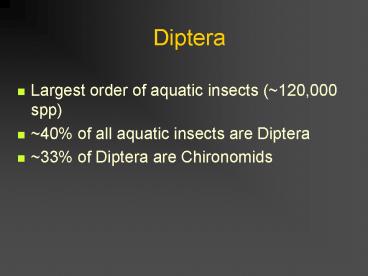Diptera - PowerPoint PPT Presentation
1 / 21
Title: Diptera
1
Diptera
- Largest order of aquatic insects (120,000 spp)
- 40 of all aquatic insects are Diptera
- 33 of Diptera are Chironomids
2
Reflect all levels of ecological diversity
- Shredders (live plants / CPOM)
- Collector / gatherers (FPOM)
- Grazers (periphyton / OM)
- Predators (other invertebrates)
3
Diptera lack segmented thoracic legs. Easily
distinguished from larvae of other aquatic
insects.
- Nematocera well-defined head mandibles move
laterally - Brachycera Head is absent (or reduced)
mandibles move vertically
4
Respiration
- Oxygen-rich environs cutaneous some spp have
gills. - Oxygen-poor environs hemoglobin-like pigment for
O2 storage. - Larvae 1) caudal respiratory siphons that reach
to water surface or 2) caudal spiracles where
they float on surface - Pupae 1) horns obtain O2 at surface, 2)
actively swim to surface, 3) pupate above the
waterline, 4) cutaneous respiration.
5
Holometabolous Order
Most dipterans have relatively short life cycles
(lt1 y)
General life Cycle
Mandipulate mouthparts
Haustellate mouthparts
Winged Adult (lt 1y)
Pupae (1-2 weeks)
Egg (days to few weeks)
Larvae (4-5 instars 1-12 mos)
6
Nematocerans have serious implications for humans
- Human health malaria, yellow fever,
encephalitis, typhoid fever (culicidae) - Annoying black flies, horse flies, biting midges
(tabanidae, simulidae) - Swarms midges, phantom midges (chironomidae,
chaoborus)
7
Tipulidae crane flies
-posterior portion of head incompletely
schlerotized and retracted into thorax.
-usually found in lotic habitats herbivores,
omnivores, carnivores present
8
Blephariceridae net-winged midges
-distinctive flattened body and 7 apparent body
segments
-usually found in fast streams where thely feed
on diatoms and other algae
9
Deuterophlebiidae mountain midges
-usually lt6mm and easily recognized by 7 pairs of
stout, ventrolateral prolegs
-usually found in rapid streams in the west on
smooth rocks at or near the surface
10
Culicidae mosquitoes
-easily recognized by 1) swollen thoracic area 2)
caudal siphon 3) flip-flop swimming motion
-found in lentic or semilotic habitats. Never
found in moving water. Feed mostly on detritus
and microorganisms. Adult males feed on plant
nectar. Females require blood.
11
Dixidae dixid midges
-recognized by pairs of prolegs on first one or
two abdominal segments.
-found at or just below water suface in lentic
habitats. Lie in a characteristic U-shape, often
resting on vegetation. Feed on detritus and
microorganisms in surface film
12
Chaoboridae phantom midges
-nearly transparent except for hydrostatic organ.
Have modified antennae for capturing
invertebrate prey.
-occur in a wide variety of lentic habitats.
ONLY insects frequently found in limnetic areas
of lakes. 4-5th instars undergo diel vertical
migration to feed on zooplankton at night
13
Psychodidae moth flies
-generally small size lt6mm and secondary
annulations on thoracic and abdominal segments
-Occur among vegetation and debris in shallow
lentic habitats. Frequently associated with
organically polluted water (e.g. even in sink and
floor drains!).
14
Thaumaleidae solitary midges
-very rare. Have a single broad anterior and
posterior proleg instead of paired prolegs.
-Larvae inhabit vertical surfaces of rocks in
cold, shady, mountain streams where water film
does not entirely cover their bodies. Feed mostly
on diatoms.
15
Chironomidae midges
-exhibit anterior and posterior pairs of prolegs,
but can be quite diverse in form and size.
-often dominant insect in littoral areas of lakes
and ponds. Larvae are very important in aquatic
food webs, serving as food for inverts and fish.
Feeding habits vary widely with herbivores,
omnivores and carnivores represented.
16
Ceratopogonidae biting midges
-usually small, elongate and without prolegs
-occur in a wide variety of aquatic habitats.
Most larvae are able swimmers and move about with
a serpentine swimming motion. Feedng ecology is
poorly known.
17
Simulidae black flies
-uniquely shaped having a swollen abdomen that
they attach to substrate with a caudal sucker.
Relatively large head and single ventral proleg
on the thorax.
-found primarily in lotic habitats. Most larvae
are filter feeders, using labral fans to filter
diatoms and other organic material. Unlike other
Nematocera, Simulidae under 6-7 instars
18
Ptychopteridae phantom crane flies
-easily recognized by their elongate caudal
respiratory siphon and pairs of prolegs on the
first 3 abdominal segments
-live in very shallow water along margins of
lakes and streams. Feed on detritus and
microorganisms.
19
Tabanidae deer fly or horse flies
-recognized by absence of prolegs and the
presence of a girdle of 6 or more pseudopods on
most abdominal segments
-mostly semiaquatic, but some spp are found in
shallow water along lake and stream margins.
Larvae are predators on other inverts. Adult
females require blood.
20
Sciomyzidae marsh flies
-generally have a wrinkled appearance with
pseudopods on abdomen.
-Larvae are found in lentic habitats and margins
of streams where they feed exclusively on snails,
slugs, or fingernail clams. Used as biological
control of liver flukes and schistosomes.
21
Lepidoptera
-- 1 family Pyralidae -- feed primarily on
emergent and submerged plants -- distinguished by
pairs of prolegs on abdominal segments -- found
in both lotic and lentic habitats with some
species developing shelters much like
trichopterans -- holometabolous life-cycle
difficult to ID to spp at larval stage.
aquatic
terrestrial
eggs - larva - pupa
adult































